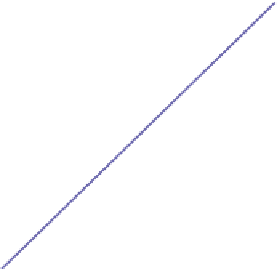Environmental Engineering Reference
In-Depth Information
(a)
(b)
1.5
3
1.0
2
0.5
1
0.0
0
-0.5
-1
r
2
= 0.86
p
< 0.001
-2
-1.0
-2
-1
0
1
2
3
-4
-2
0
2
4
6
log
10
estimated production
log
10
W
m
(mg dry mass)
(c)
0
10
20
30
40
50
60
70
80
90
100
0
5
10
15
20
Annual mean temperature (
°
C)
FIGURE 3.4
An example of an empirical model to predict secondary production of individual species of,
in this case, marine benthic invertebrates. (a) Estimated versus measured production, showing precision and
bias of model
results (log
10
P
5
0.18
1
0.97log
10
B
2
0.22log
10
W
m
1
0.04
T
2
0.014Tlog
10
(
z
1
1)
(
P
5
production,
B
water depth). (b) The effect of
body size on annual turnover (
P/B
). (c) Effect of temperature and habitat location on turnover rates (annual
P/B
), for a species of average biomass (19 g/m
2
) and large body size (1.2 g dry mass).
(Redrawn from
Tumbiolo
and Downing 1994.
)
5
mean annual biomass,
W
m
5
individual body mass,
T
5
temperature,
z
5
mean annual biomass to do so.
Benke (1993)
argued that such models are not statistically
valid because production is a mathematical function of biomass, so biomass-production
plots are a case of self-correlation. In addition, mean annual biomass is not an ideal predic-
tor because estimates of mean annual biomass often are costly and error-prone. In fact, in
many cases, if the necessary data have been collected to estimate mean annual biomass
satisfactorily, relatively little additional effort is required to gather the data to estimate
production directly.





























































































































































